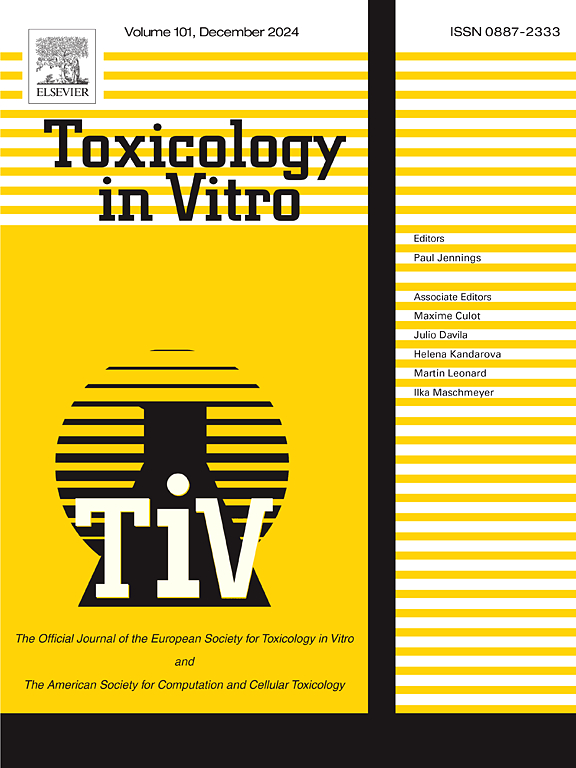香烟侧流烟雾诱导的细胞衰老及组蛋白H2AX的保护作用
IF 2.6
3区 医学
Q3 TOXICOLOGY
引用次数: 0
摘要
吸烟会造成严重的健康危害,如癌症和心血管疾病,但也与细胞衰老有关。近年来,组蛋白的丢失和修饰被认为是细胞衰老的特征之一。在这项研究中,我们研究了香烟烟雾诱导的细胞衰老与组蛋白H2A变体H2AX之间的关系,H2A变体H2AX是DNA损伤反应的重要参与者。我们将正常人皮肤二倍体成纤维细胞ASF-4-1暴露于香烟侧流烟雾(CSS)提取物中,成功地诱导了人皮肤早衰。已知持续的DNA损伤会诱导细胞衰老。在css处理的细胞中检测到双链断裂(DSBs)的形成,表明DSBs可能是css诱导的细胞衰老的原因。在衰老细胞中,观察到组蛋白H2AX (γ-H2AX)的持续磷酸化和H2AX蛋白表达的意外增加。为了阐明H2AX在css诱导的细胞衰老中的作用,我们用siRNA在ASF-4-1细胞中去除H2AX。在h2ax -缺失的细胞中,css诱导的β-半乳糖苷酶活性升高更为明显。H2AX耗竭也促进了CSS浓度依赖性活性氧的增加和dsb的形成。这些结果表明,组蛋白H2AX可能对DNA损伤诱导的过早衰老具有保护作用。本文章由计算机程序翻译,如有差异,请以英文原文为准。

Cigarette sidestream smoke-induced cellular senescence and the protective role of histone H2AX
Cigarette smoke imposes serious health hazards such as cancer and cardiovascular diseases but is also associated with cellular senescence. Recently, histone loss and modifications are reported as one of the characteristics of cellular senescence. In this study, we examined the relationship between cigarette smoke-induced cellular senescence and histone H2A variant H2AX, an important player in DNA damage response. We exposed normal human skin diploid fibroblast ASF-4-1 to cigarette sidestream smoke (CSS) extract and successfully induced premature senescence. Persistent DNA damages are known to induce cellular senescence. Double strand breaks (DSBs) formation was detected in CSS-treated cells, indicating DSBs could be the cause for the CSS-induced cellular senescence. In the senescent cells, persistent phosphorylation of histone H2AX (γ-H2AX) and unexpected increase of H2AX protein expression was observed. To elucidate the role of H2AX in CSS-induced cellular senescence, we depleted H2AX in ASF-4-1 cells with siRNA. In H2AX-depleted cells, CSS-induced elevated β-galactosidase activity was more prominent. CSS concentration-dependent increase of reactive oxygen species and DSBs formation was also facilitated by H2AX depletion. These results suggest that histone H2AX may have a protective role against DNA damage-induced premature senescence.
求助全文
通过发布文献求助,成功后即可免费获取论文全文。
去求助
来源期刊

Toxicology in Vitro
医学-毒理学
CiteScore
6.50
自引率
3.10%
发文量
181
审稿时长
65 days
期刊介绍:
Toxicology in Vitro publishes original research papers and reviews on the application and use of in vitro systems for assessing or predicting the toxic effects of chemicals and elucidating their mechanisms of action. These in vitro techniques include utilizing cell or tissue cultures, isolated cells, tissue slices, subcellular fractions, transgenic cell cultures, and cells from transgenic organisms, as well as in silico modelling. The Journal will focus on investigations that involve the development and validation of new in vitro methods, e.g. for prediction of toxic effects based on traditional and in silico modelling; on the use of methods in high-throughput toxicology and pharmacology; elucidation of mechanisms of toxic action; the application of genomics, transcriptomics and proteomics in toxicology, as well as on comparative studies that characterise the relationship between in vitro and in vivo findings. The Journal strongly encourages the submission of manuscripts that focus on the development of in vitro methods, their practical applications and regulatory use (e.g. in the areas of food components cosmetics, pharmaceuticals, pesticides, and industrial chemicals). Toxicology in Vitro discourages papers that record reporting on toxicological effects from materials, such as plant extracts or herbal medicines, that have not been chemically characterized.
 求助内容:
求助内容: 应助结果提醒方式:
应助结果提醒方式:


